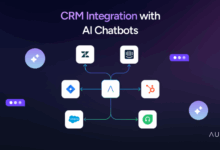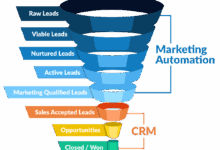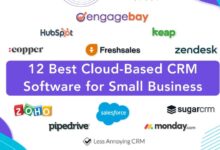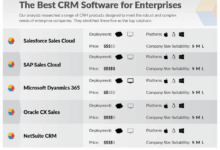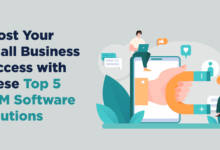Affordable CRM Software for Startups
Affordable CRM Software for Startups: Navigating the landscape of customer relationship management (CRM) can feel overwhelming for a new business. Finding the right balance between functionality, cost-effectiveness, and scalability is crucial for sustainable growth. This exploration delves into the key considerations for startups seeking affordable yet powerful CRM solutions, examining pricing models, essential features, and future-proofing strategies. We’ll equip you with the knowledge to make an informed decision that aligns with your budget and growth trajectory.
From understanding the various pricing models offered by CRM vendors to identifying the core features essential for early-stage businesses, we’ll unpack the critical aspects of selecting an affordable CRM. We’ll also discuss the importance of seamless integration with other business tools and the need for a solution that can scale as your startup expands. Ultimately, our aim is to empower you to choose a CRM that not only fits your current needs but also supports your long-term ambitions.
Defining “Affordable” for Startups
Affordability in CRM software for startups is a relative concept, heavily dependent on the specific needs and financial resources of the business. It’s not simply about the lowest price tag; rather, it’s about finding the best value for money – a CRM solution that provides the necessary features and scalability at a price point that aligns with the startup’s budget and growth trajectory.
Factors influencing the affordability of CRM software for startups include the startup’s overall budget, the specific features required to manage their customer interactions and sales processes, and the anticipated growth and scalability needs. A bootstrapped startup with limited funding will naturally prioritize cost-effectiveness more than a venture-backed company with significant capital. Similarly, a startup focused solely on lead generation will have different software requirements and thus different affordability considerations than a startup managing complex customer service interactions.
Pricing Models for CRM Software
Several pricing models are commonly used by CRM software vendors, each catering to different needs and budgets. Understanding these models is crucial for startups to choose a solution that fits their financial constraints.
Subscription-based pricing is the most prevalent model, offering a recurring monthly or annual fee for access to the software. This provides predictable budgeting and often includes automatic updates and customer support. Tiered pricing offers different subscription levels with varying features and user limits, allowing startups to choose a plan that matches their needs and budget. Freemium models offer a basic version of the software for free, with paid options providing enhanced features and functionality. This can be an attractive entry point for startups with limited resources, allowing them to upgrade as they grow.
Comparison of Affordable CRM Options
The following table compares the pricing structures of three popular affordable CRM options. Note that pricing can change, and it’s essential to check the vendor’s website for the most up-to-date information.
| Software Name | Pricing Model | Key Features | Target User |
|---|---|---|---|
| HubSpot CRM | Freemium (with paid options) | Contact management, email marketing, sales pipeline management, reporting and analytics. | Startups with limited budgets and basic CRM needs, scaling to larger businesses. |
| Zoho CRM | Tiered subscription | Contact management, sales automation, customer support, marketing automation, integrations. | Startups and small businesses needing a comprehensive CRM solution at a reasonable price. |
| Freshsales | Tiered subscription | Sales pipeline management, contact management, email integration, phone integration, reporting. | Sales-focused startups needing a robust solution for managing leads and sales processes. |
Essential Features for Startup CRMs
Choosing the right CRM is crucial for a startup’s success. A well-selected system streamlines operations, improves sales efficiency, and fosters stronger customer relationships, all while staying within a manageable budget. Focusing on essential features rather than unnecessary complexity is key during the early stages of growth.
Early-stage businesses need a CRM that handles core functions efficiently. Overly simplified systems might lack the scalability needed for future growth, while overly complex systems can overwhelm teams and hinder adoption. The ideal balance lies in selecting a system with a robust core functionality set that can adapt as the business expands.
Contact Management
Effective contact management forms the bedrock of any successful CRM. This involves the ability to store, organize, and access comprehensive information about each customer or prospect. This includes contact details (name, email, phone number, address), interaction history (emails, calls, meetings), and any relevant notes or tags. For instance, a startup using a CRM with robust contact management can easily segment its audience based on demographics, purchase history, or engagement level, enabling targeted marketing campaigns and personalized outreach. This leads to higher conversion rates and improved customer satisfaction. Without this, sales teams may struggle to maintain consistent communication and track interactions, potentially leading to lost opportunities and frustrated customers.
Lead Tracking and Scoring
Lead tracking is essential for monitoring the progress of potential customers through the sales pipeline. A CRM should allow for easy lead capture from various sources (website forms, marketing campaigns, referrals), automated lead assignment, and tracking of interactions and engagement. Lead scoring, a feature that assigns a numerical value to each lead based on pre-defined criteria (e.g., website activity, engagement with marketing materials), helps prioritize high-potential leads for focused attention. For example, a SaaS startup might use lead scoring to identify leads who have downloaded multiple white papers or requested a demo, indicating a higher likelihood of conversion. This allows sales teams to focus their efforts effectively, maximizing their time and resources. Lacking this capability can lead to inefficient resource allocation and missed opportunities to engage high-value leads.
Basic Sales Pipeline Management
Visualizing the sales process through a pipeline is critical for monitoring progress and identifying bottlenecks. A startup CRM should provide a clear view of where each lead or opportunity stands in the sales cycle (e.g., prospect, qualified lead, proposal sent, closed-won). This visual representation helps teams track their progress towards sales targets, identify areas for improvement, and manage their workload more effectively. For example, a team can quickly see which deals are at risk of falling through and proactively address any issues. Without a clear pipeline view, tracking progress and identifying potential problems becomes significantly more difficult, leading to decreased sales efficiency and missed revenue opportunities.
Drawbacks of Overly Simplified or Feature-Rich CRMs
Using an overly simplified CRM might initially seem cost-effective, but it often lacks the essential features needed for growth. This can lead to inefficiencies, data silos, and ultimately hinder sales performance. Conversely, selecting a CRM overloaded with features can be equally detrimental. The complexity can lead to user confusion, low adoption rates, and wasted resources on functionalities the startup doesn’t actually need. The ideal approach is to find a balance, selecting a system with the core functionalities needed now, while ensuring it’s scalable to accommodate future growth.
Integration Capabilities
A robust CRM system for a startup isn’t just about managing contacts; it’s about seamlessly connecting all aspects of your business. Effective integration with other crucial tools significantly boosts productivity and streamlines workflows, allowing your team to focus on growth rather than juggling disparate systems. The right integrations can transform data silos into a unified source of truth, fueling informed decision-making and ultimately, faster scaling.
Integrating your CRM with other business tools eliminates redundant data entry, reduces the risk of errors, and provides a holistic view of your customer interactions. This interconnectedness allows for automated workflows, improved team collaboration, and more efficient use of resources. The benefits are particularly pronounced for startups operating on lean budgets and smaller teams, where maximizing efficiency is paramount.
Examples of Integrations Boosting Startup Efficiency
Seamless data flow between different platforms is key to a startup’s success. Consider the impact of integrating your CRM with an email marketing platform. This allows for automated email sequences triggered by specific customer actions within the CRM, such as a new contact being added or a deal being closed. Imagine the time saved by automatically segmenting your audience based on CRM data and sending targeted email campaigns, instead of manually managing these tasks. Similarly, integrating your CRM with social media platforms provides a centralized view of customer interactions across multiple channels, enabling faster response times and more personalized engagement. Integrating accounting software with your CRM allows for automated invoicing and tracking of revenue generated from specific customer interactions, providing valuable insights into sales performance and customer lifetime value.
Comparison of Integration Capabilities in Affordable CRM Solutions
Choosing the right affordable CRM often involves careful consideration of its integration capabilities. Below is a comparison of three popular options, highlighting their strengths and weaknesses in this area:
- HubSpot CRM (Free plan available): Offers a wide range of integrations through its marketplace, including popular email marketing platforms (Mailchimp, Constant Contact), social media platforms (Facebook, Twitter), and various accounting software (Xero, QuickBooks). Its robust API also allows for custom integrations. However, some advanced integrations might require a paid plan.
- Zoho CRM (Free plan available): Provides a comprehensive suite of integrations with its own ecosystem of tools, as well as integrations with third-party applications. It integrates well with popular email marketing services and several accounting software options. While its integration capabilities are strong, the interface might feel less intuitive to some users compared to HubSpot.
- Freshsales CRM (Free plan available): Offers a solid range of integrations, particularly with email marketing platforms and a few accounting software options. However, its integration marketplace is smaller than HubSpot’s, limiting the choices for businesses with more niche software needs. The free plan’s integration capabilities might be more limited compared to the paid plans.
Scalability and Future Growth
Choosing a CRM that can adapt to your startup’s growth is crucial for long-term success. A system that works well for a team of five might become a bottleneck as your company expands to fifty, or even five hundred. Understanding scalability from the outset prevents costly migrations and disruptions later on. This section explores factors to consider and strategies for planning scalable CRM implementation.
Choosing a CRM that scales effectively involves assessing several key factors. Primarily, you need to consider your anticipated growth trajectory. Will you add more users? Will you require more complex features or integrations as you expand into new markets or offer more services? The CRM’s architecture, its ability to handle increasing data volumes, and its support for customisation all play significant roles in its long-term viability. Furthermore, the vendor’s track record in supporting scaling businesses, their customer support infrastructure, and the availability of advanced features like automation and reporting should be thoroughly investigated.
Factors Influencing CRM Scalability
The scalability of a CRM system depends on several intertwined factors. A robust database infrastructure is paramount, capable of handling the exponential increase in data as your customer base grows. The CRM’s architecture should be flexible and adaptable, allowing for the addition of new users, features, and integrations without significant performance degradation. Consider whether the platform offers features like workflow automation, which becomes increasingly important as your operations become more complex. Finally, the vendor’s commitment to ongoing development and updates ensures the CRM stays relevant and efficient as your business evolves. A CRM that stagnates will quickly become a liability.
Planning for CRM Scalability: A Step-by-Step Guide
Planning for CRM scalability isn’t a one-time event; it’s an ongoing process that requires proactive assessment and adaptation.
- Assess Current and Future Needs: Begin by meticulously documenting your current CRM requirements. Then, project your needs for the next 12, 24, and 36 months. Consider factors like anticipated user growth, new features needed, and potential integrations with other software. For example, a startup launching a new product line might need additional fields to track inventory and order fulfillment.
- Evaluate CRM Options: Based on your needs projection, research and evaluate different CRM systems. Pay close attention to their scalability claims, supported user numbers, and performance benchmarks. Look for case studies showcasing how the CRM has handled growth in similar businesses. For instance, a CRM used successfully by a similar-sized company in your industry provides a strong indication of its potential for your own business.
- Choose a Flexible Pricing Model: Opt for a pricing model that accommodates growth without significant price jumps. Tiered pricing or pay-as-you-go models are generally more scalable than fixed-price contracts. This allows you to adjust your CRM spending as your needs change.
- Implement a Phased Rollout: Instead of a complete overhaul, consider a phased rollout of the CRM. This allows for testing and refinement before expanding its use throughout the organization. Start with a small group of users and gradually increase adoption as you gain confidence and address any initial issues.
- Establish Regular Reviews: Schedule regular reviews of your CRM usage and performance. These reviews should assess whether the system is still meeting your needs and identify any potential bottlenecks before they impact productivity. These reviews should include discussions about future needs and potential adjustments to the system or pricing plan.
CRM Pricing Models and Scalability
Different CRM pricing models offer varying degrees of scalability. Understanding these models is essential for choosing a solution that aligns with your growth strategy.
- Per-user pricing: This model charges a fixed fee per user. While simple, it can become expensive as your team grows. However, many vendors offer volume discounts to mitigate this.
- Tiered pricing: This model offers different pricing tiers with varying features and user limits. As your needs grow, you can upgrade to a higher tier, accessing more advanced features and accommodating more users.
- Pay-as-you-go: This model charges based on actual usage. It offers excellent flexibility and scalability, allowing you to pay only for what you use. However, it might require careful monitoring to avoid unexpected costs.
User-Friendliness and Ease of Implementation
For startups, choosing a CRM is about more than just features; it’s about seamless integration into daily workflows. A user-friendly system minimizes the learning curve, ensuring rapid adoption and maximizing the return on investment. This is especially crucial for startups with limited resources and potentially less technical expertise among their teams.
A user-friendly interface and intuitive navigation are paramount for efficient CRM utilization. A system that’s difficult to navigate or understand will lead to frustration, reduced adoption, and ultimately, wasted investment. For a lean startup operating with a small team, every minute counts; therefore, ease of use directly impacts productivity and profitability.
Intuitive Interface Design
An intuitive interface is characterized by clear visual hierarchy, consistent design elements, and straightforward navigation. Imagine a CRM dashboard that instantly presents key performance indicators (KPIs) like sales pipeline progress and customer engagement metrics in an easily digestible format. This visual clarity minimizes the time spent searching for information and allows users to quickly assess the overall health of their business relationships. Effective use of color-coding, clear labeling, and logical grouping of information contributes significantly to a positive user experience. Furthermore, a consistent design language across different sections of the software prevents confusion and allows for faster learning.
Essential Features Contributing to Positive User Experience
The ease of use of a CRM is significantly influenced by its core features. A well-designed system should prioritize simplicity and efficiency.
- Drag-and-drop functionality: Allows for intuitive organization of tasks, contacts, and deals.
- Customizable dashboards: Enables users to tailor their view to focus on the most relevant information.
- Simplified reporting and analytics: Provides easily understandable visualizations of key metrics without requiring advanced data analysis skills.
- Robust search functionality: Allows quick access to specific contacts, deals, or information.
- Contextual help and tooltips: Provides immediate assistance and explanations without requiring extensive training.
Typical Implementation Process and Onboarding
The implementation process for affordable CRM systems is generally straightforward and designed to minimize disruption. Many vendors offer cloud-based solutions that require minimal IT infrastructure. The process typically involves:
- Account setup and configuration: This often involves customizing the system to align with the startup’s specific needs and workflows. This may include mapping existing customer data.
- Data migration (if applicable): Transferring existing customer data from legacy systems to the new CRM.
- User training and onboarding: Most vendors provide training materials, tutorials, and often live onboarding sessions to guide users through the system’s functionalities. This ensures rapid user adoption and minimizes any initial confusion.
- Ongoing support and maintenance: Access to customer support channels, documentation, and potentially dedicated account managers ensures a smooth transition and ongoing assistance.
Data Security and Privacy
Protecting your startup’s customer data is paramount, not only for ethical reasons but also to maintain customer trust and avoid legal repercussions. Choosing a CRM with robust security features is crucial for safeguarding sensitive information and ensuring compliance with regulations like GDPR and CCPA. A breach can severely damage your reputation and lead to significant financial losses.
Data security measures in a CRM should go beyond basic password protection. Startups need to carefully assess the security protocols offered by potential CRM providers to ensure their data is adequately protected.
Essential Data Security Measures for Startup CRMs
Startups should prioritize CRMs offering a multi-layered approach to security. This includes robust authentication methods like two-factor authentication (2FA), encryption both in transit and at rest, regular security audits, and comprehensive data loss prevention (DLP) strategies. Furthermore, the CRM provider should have a clear and transparent security policy outlining their procedures for handling data breaches and incidents. This policy should detail how they will notify affected customers and what steps they will take to remediate the situation.
Examples of Security Features Protecting Sensitive Customer Data
Several features contribute to a secure CRM environment. Encryption, for instance, transforms data into an unreadable format, protecting it from unauthorized access. Data encryption should occur both while data is being transmitted (in transit) and while it’s stored (at rest). Access controls, such as role-based permissions, restrict access to sensitive data based on employee roles and responsibilities. This ensures that only authorized personnel can view or modify specific information. Regular security audits and penetration testing by independent security experts help identify vulnerabilities and ensure the CRM system remains secure. Finally, intrusion detection and prevention systems monitor the CRM for suspicious activity, alerting administrators to potential threats in real-time.
Visual Representation of Data Security Protocols in a CRM System
Imagine a diagram showing data flowing through several security checkpoints. First, data enters the system through a secure portal, protected by 2FA. This data is then encrypted in transit using HTTPS. Once stored in the CRM database, the data is encrypted at rest using AES-256 encryption. Access to the database is controlled by role-based permissions, meaning only authorized users with the appropriate roles can access specific data. The entire system is monitored by an intrusion detection system, which constantly scans for suspicious activities. Regular security audits and penetration testing are represented as external checks, verifying the system’s overall security posture. In the event of a breach, incident response protocols are activated, involving notification to affected parties and remediation efforts. This visual flow emphasizes the layered security approach, highlighting how multiple security measures work together to protect data at every stage.
Customer Support and Resources
Implementing a new CRM system, even an affordable one, requires support. Startups often lack the internal resources to troubleshoot complex issues or fully understand all the nuances of a new software platform. Access to reliable customer support and readily available resources is therefore crucial for a smooth transition and successful CRM adoption. This directly impacts productivity and the overall return on investment.
Effective customer support significantly reduces the learning curve, minimizing downtime and maximizing the value derived from the CRM. Comprehensive resources empower users to independently resolve minor issues, freeing up support channels for more complex problems. The availability and quality of support should be a key factor when selecting a CRM solution for a startup.
Types of Customer Support Offered by CRM Providers
Various support options cater to different preferences and needs. Effective CRM providers offer a multi-faceted approach, combining various methods for optimal accessibility.
- Phone Support: Direct phone access to support representatives provides immediate assistance for urgent issues, allowing for quick resolution of critical problems and real-time guidance. This is particularly valuable for complex troubleshooting or when dealing with time-sensitive situations.
- Email Support: Email support allows for detailed problem descriptions and often provides a written record of the interaction, useful for reference. It’s suitable for less urgent issues requiring detailed explanations or when attachments are necessary.
- Online Chat Support: Real-time chat offers a quick and convenient way to address immediate questions or minor issues without the need for a phone call. It’s particularly beneficial for quick queries or troubleshooting simple problems.
- Comprehensive Documentation: Well-structured documentation, including tutorials, FAQs, and user manuals, empowers users to resolve common issues independently. This reduces the burden on support teams and allows users to learn at their own pace.
- Knowledge Base/Help Center: A searchable knowledge base provides access to a wealth of information, addressing common questions and providing solutions to frequently encountered problems. This self-service option is crucial for empowering users to become independent problem solvers.
- Video Tutorials: Visual learning aids can be extremely helpful in understanding complex features or workflows. Short, targeted videos can significantly improve user understanding and adoption.
Customer Support Comparison of Three Affordable CRM Solutions
The following is a comparative analysis of customer support offered by three hypothetical affordable CRM solutions (actual offerings may vary). Note that this is a illustrative example and should not be taken as definitive statements about specific products.
| CRM Solution | Phone Support | Email Support | Online Chat Support | Documentation |
|---|---|---|---|---|
| CRM A | Limited hours, basic support | Standard response time within 24-48 hours | Available during business hours | Comprehensive online help center and user manual |
| CRM B | 24/7 phone support | Quick response time (within 4 hours) | 24/7 chat support | Extensive documentation, video tutorials, and knowledge base |
| CRM C | No phone support | Response time varies, typically within 2 business days | Limited chat support during peak hours | Basic documentation and FAQs |
Epilogue
Selecting the right affordable CRM software is a pivotal decision for any startup. By carefully considering factors such as pricing models, essential features, scalability, user-friendliness, and data security, startups can equip themselves with a powerful tool to manage customer relationships, streamline sales processes, and ultimately drive growth. Remember that the ideal CRM is not just a software; it’s a strategic investment that fosters efficiency and fuels sustainable success. Choosing wisely ensures that your CRM becomes a valuable asset, supporting your journey from startup to established business.
